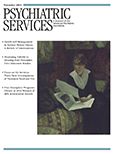Trends in Psychotropic Polypharmacy Among Youths Enrolled in Ohio Medicaid, 2002–2008
Abstract
Objective:
This study examined polypharmacy patterns and rates over time among Medicaid-enrolled youths by comparing three enrollment groups (youths in foster care, with a disability, or from a family with low income).
Methods:
Serial cross-sectional trend analyses of Medicaid claims data were conducted for youths age 17 and younger who were continuously enrolled in Ohio Medicaid for a one-year period and prescribed one or more psychotropic medications during fiscal years 2002 (N=26,252) through 2008 (N=50,311). Outcome measures were any polypharmacy (three or more psychotropic medications from any drug class) and multiclass polypharmacy (three or more psychotropic medications from different drug classes).
Results:
Both types of polypharmacy increased across all three eligibility groups. Any polypharmacy increased from 8.8% to 11.5% for low-income youths (adjusted odds ratio [AOR]=1.12, 99% confidence interval [CI]=1.10–1.13), from 18.0% to 24.9% for youths with a disability (AOR=1.11, CI=1.09–1.13), and from 19.8% to 27.3% for youths in foster care (AOR=1.09, CI=1.07–1.11). Combinations associated with positive increases were two or more antipsychotics, two or more stimulants, and antipsychotics with stimulants.
Conclusions:
Polypharmacy increased across all enrollment groups, with the highest absolute rates for youths in foster care. Both the overall prevalence and increases in prescriptions for drug combinations with limited evidence of safety and efficacy, such as the prescription of two or more antipsychotics, underscore the need for targeted quality improvement efforts. System oversight and monitoring of psychotropic medication use appears to be warranted, especially for higher-risk groups, such as youths in foster care and those from low-income households who were prescribed multiple antipsychotics.



